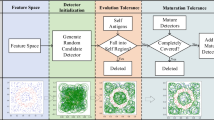Abstract
In this paper, we introduce the application of transformation pattern recognition based on a complex artificial immune system. The key feature of the complex artificial immune system is the introduction of complex data representation. We use complex numbers as the data representation instead of binary numbers used before, besides the weight between different layers. The complex partial autocorrelation coefficients of input antigen which are considered as the antigen presentation are calculated in major histocompatibility complex (MHC) layer of the complex artificial immune system. In the simulations, the transformation of patterns, such as translation, scale or rotation, are recognized in much higher accuracy, and it has obviously higher noise tolerance ability than traditional real artificial immune system and even the complex PARCOR model.


















Similar content being viewed by others
References
Castinglione F, Motta S, Nicosia G (2001) Pattern recognition by primary and secondary response of an artificial immune system. Theory Biosci 120(2):93–106
Dai HW, Tang Z, Yang Y, Tamura H (2006) Affinity based lateral interaction artificial immune system. IEICE Trans Inf Syst E89-D(4):1515–1523
Dasgupta D (1996) Using immunological principles in anomaly detection. In: Proceedings of the artificial neural networks in engineering (ANNIE96). St Louis, USA, November, pp 10–13
Dasgupta D (1999) Immune-based intrusion detection system: a general framework. National Information Systems Security Conference (NISSC)
Dasgupta D, Forrest S (1996) Novelty detection in time series data using ideas from immunology. In: ISCA 5th international conference on intelligent systems. Reno, Nevada, pp 19–21
Dasgupta D, Krishna Kumar K, Wong D, Berry M (2004) Negative selection algorithm for aircraft fault detection. In: The proceedings of the third international conference, ICARIS2004 on artificial immune systems
de Castro LN (2000) Artificial immune system: part II—a summary of applications. FEEC/University Campinas, Campinas
de Castro LN, Timmis J (2002) Artificial immune systems: a novel paradigm to pattern recognition. In: Corchado JM, Alonso L, Fyfe C (eds) Artificial neural networks in pattern recognition, SOCO-2002. University of Paisley, UK, pp 67–84
Forrest S, Javornik B, Smith RE, Perelson AS (1993) Using genetic algorithms to explore pattern recognition in the immune system. Evol Comput 1(3):191–211
Glodsby R, Kindt T, Kuby J, Osborne B (2003) Immunology. W.H. Freeman, New York
Hunt JE, Cooke DE (1996) Learning using an artificial immune system. J Netw Comput Appl 19:189–212
Kim J, Bentley P (2002) Toward an artificial immune system for network intrusion detection: an investigation of dynamic clonal selection. In: Proceedings of the 2002 congress on evolutionary computation (CEC 2002). Honolulu, Hawaii, pp 1244–1252
Kohonen T (1990) The self-organizing map. Proc IEEE 78:1464–1480
Krishna Kumar K, Neidhoefer J (1999) Immunized adaptive critic for an autonomous aircraft control application. In: Chapter 20 in the book entitled artificial immune systems and their applications. Springer, Berlin pp 221–240
Otsu N, Kurita T (1989) Proposal of complex autoregressive model as a shape descriptor. IEEE Trans Natl Conv Rec IEICE Jpn D-496
Sekita I, Kurita T, Otsu N (1990) Shape reconstruction from complex autoregressive coefficients. IEEE Trans Nat Conv Rec IEICE Japan D-258
Sekita I, Kurita T, Otsu N (1991) Complex autoregressive model and its properties. Tech rep ETL, TR-91-12
Sekita I, Kurita T, Otsu N (1992) Complex autoregressive model for shape recognition. IEEE Trans Pattern Anal Mach Intel 14(4):
Sun WD, Tang Z, Tamura H, Ishii M (2003) An artificial immune system architecture and its applications. IEICE Trans Fundam E86.A(7):
Tang Z, Hebishima H, Tashima K, Ishizuka O, Tanno K (1997) An immune network based on biological immune response network and its immunity. IEICE Trans Funda J80-A(11):1940–1950
Timmis J, Knight T (2001) Artificial immune systems: using the immune as inspiration for data mining. In: Hussein RAS, Abbass A, Newton Charles S (eds) Data mining: a heuristic approach. Idea Group Publishing, Hershey, pp 209–320
Timmis J, Neal M, Knight T (2002) AINE: machine learning inspired by the immune system. Published in IEEE transactions on evolutionary computation
U.S. Department of Health and Human Services National Institutes of Health (2003) Understanding the immune system-How it works, NIH Publication No.03-5423
White JA, Garrett SM (2003) Improved pattern recognition with artificial clonal selection. In: Proceedings of the 2nd international conference on artificial immune systems, pp 181–193
Author information
Authors and Affiliations
Corresponding author
Rights and permissions
About this article
Cite this article
Wang, W., Gao, S. & Tang, Z. Improved pattern recognition with complex artificial immune system. Soft Comput 13, 1209–1217 (2009). https://doi.org/10.1007/s00500-009-0418-0
Published:
Issue Date:
DOI: https://doi.org/10.1007/s00500-009-0418-0




